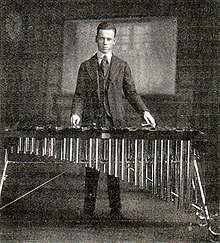George Hamilton Green
George Hamilton Green, Jr. (May 23, 1893 – 1970) was a xylophonist, composer, and cartoonist born in Omaha, Nebraska. He was born into a musical family, both his grandfather and his father being composers, arrangers, and conductors for bands in Omaha. From age four G.H. Green showed a prodigious talent as a pianist; he then took up the xylophone and by the age of eleven was being promoted as the “world’s greatest xylophonist” and was playing for crowds of 7,000-10,000.[1] In 1915, when Green was 22 years old, a review in the United States Musician stated: "He has begun where every other xylophone player left off. His touch, his attack, his technique, and his powers of interpretation in the rendition of his solos being far different than other performers. To say his work is marvelous and wonderful would not fully express it." George Hamilton Green wrote several pieces for solo ragtime xylophone with accompaniment, as well as a xylophone method book which continues to be used by percussion pedagogues across the country. Some of his compositions for xylophone include: "Ragtime Robin", "Cross Corners", "Charleston Capers", "Rainbow Ripples", "Log Cabin Blues", "The Whistler", and "Jovial Jasper"[2]

He was a popular recording artist starting in 1917 with the Edison Company and was employed, along with his two brothers, Joe and Lew Green, as the original sound music crew for Walt Disney’s first three cartoons.[3]
According to Nathaniel Shilkret,[4] Green was not only a "wonderful xylophone artist," but an inventor. Shilkret said that Green designed the vibraphone at Shilkret's request.
Green was an important ragtime composer and authored many pieces that remain standards for the instrument even today.[5] He retired from performing in the late 1940s to pursue a successful career in cartooning. Green would die in 1970, just a few years before a revival in the popularity of his ragtime xylophone music, and before his induction into the Percussive Arts Society Hall of Fame in 1983 [6] The rebirth of his music was led by members of the NEXUS Percussion Ensemble in the late 1970s. Through their efforts, G.H. Green’s xylophone music has been preserved and remains a relevant part of contemporary percussion pedagogy and performance.
See also
- Music in Omaha, Nebraska
- Xylophone
- NEXUS
References
- Gracyk, T. and Hoffman, F.W. (2000) Popular American recording pioneers, 1895-1925. Haworth Press, 2000, p 147 (LCCN 99-49825) (ISBN 1560249935)
- Archived 2017-09-11 at the Wayback Machine Percussive Arts Society. Retrieved 4/27/09.
- "Artist Bios". Meredith Music Publications Composer and Author Biographies. Retrieved 2010-02-16.
- Shilkret, Nathaniel, ed. Shell, Niel and Barbara Shilkret, Nathaniel Shilkret: Sixty Years in the Music Business, Scarecrow Press, Lanham, Maryland, 2005 (LCCN 2004-58928) (ISBN 0810851288)
- Schuller, G. (1991) The swing era: the development of jazz, 1930-1945. Oxford University Press US. p 514 (LCCN 87-1664) (ISBN 019504312X)
- "Hall of Fame". Percussive Arts Society. Archived from the original on 2009-11-17. Retrieved 2010-02-16.
External links
- Works by George Hamilton Green at Project Gutenberg
- Works by or about George Hamilton Green at Internet Archive
- Discography of George Hamilton Green on Victor Records from the Encyclopedic Discography of Victor Recordings (EDVR)
- The Green Bros. - Lew Green Jr. interviewed by Jerry Fabris on Thomas Edison's Attic radio program, WFMU, August 24, 2004.